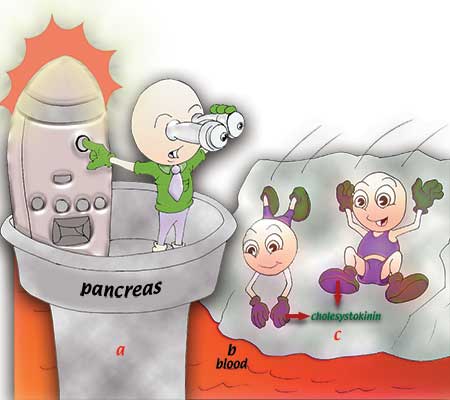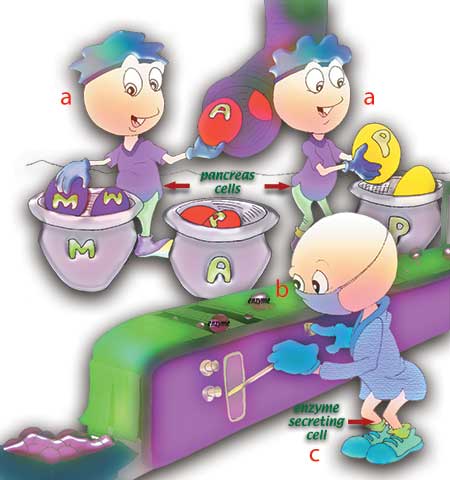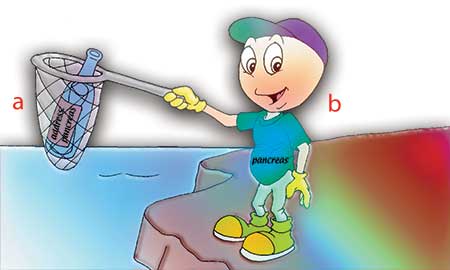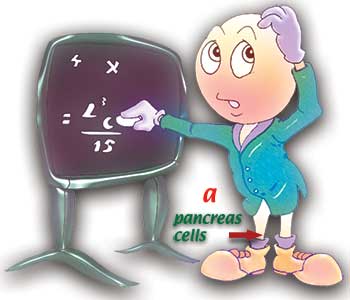GLet us imagine that you have eaten a pleasant dinner. You may never have considered how you will digest that wide range of foodstuffs. You may not even be aware that each one of them must be processed by different enzymes.
It’s of course perfectly normal that someone who has never received special training on this subject should be unaware of these facts. Yet one organ in the body does possess all this information. It knows which foods will be digested by which enzymes; and dispatches the right chemical secretion to the foodstuffs, at just the right time, with no confusion or error ever arising.
 |
| a. Pancreas |
| Figure 132: A special message is needed for the pancreas to go into action during digestion. This message is the release of a special enzyme known as cholesystokinin into the bloodstream. When this enzyme reaches a specific level, the pancreas is stimulated. At this, the pancreas starts secreting breakdown enzymes into the duodenum. |
This organ is the pancreas, one of the most important organs in the body. It decides how many sugar molecules there should be in the blood flowing through your veins. If the number of sugar molecules in the blood has declined, the pancreas immediately takes steps to raise that number;, and these measures save the life of the individual concerned. If the number of sugar molecules rises, then it takes steps to reduce their number.
With the enzymes it sends to the digestive system, the pancreas plays a most important role in human life. At the same time, the enzyme that prevents the intestine itself from being broken down by stomach acids is also produced by the pancreas.
If we look at these tasks one by one, we see that this organ, which may never have attracted your notice, acts in a very conscious and planned manner on your behalf, and it possesses a flawless system that keeps you alive.
The pancreas’ entry into action in the digestive system takes place with a special message. As the digestive processes continue in the stomach, a special enzyme called cholesystokinin begins to enter the bloodstream. When this enzyme reaches a certain level in the blood, this stimulates the pancreas, notifying it that the time for action has come, whereupon the pancreas begins secreting fragmenting enzymes into the duodenum. 28(Figure 132).
The pancreas is not limited to understanding that the digestion process has begun, it also understands what varieties of food you have eaten—and produces digestive enzymes in line with those different foods. For instance, when you eat pasta and bread, which are rich in carbohydrates, the enzyme secreted by the pancreas is of a kind able to break down carbohydrates. When these foods reach the duodenum, the pancreas produces an enzyme known as amylase (Figure 133).
 |
| a. pancreas cells |
| Figure 133: The pancreas identifies the foods entering the stomach and secretes different enzymes to digest them. |
If you consume foods like red meat, fish and chicken, the pancreas immediately recognizes that you have eaten protein. And again, when these foods reach the duodenum, the pancreas secretes different enzymes, such as trypsin, chymotrypsin, carboxypepsidase, ribonuclease and deoxyribonuclease, which break down protein. If the food you eat has a high fat content, then yet another enzyme, lipase, goes into action alongside these other enzymes, to digest the fat.
As you see, this organ understands what the foods you eat consists of, then produces one by one the proper chemical fluids needed for each one to be digested, but only at the time when they are required. The pancreas never secretes an enzyme that breaks down protein for carbohydrate molecules, nor one that breaks down carbohydrate for fat molecules. It never forgets the chemical formulae of the complex enzymes it produces. No requisite substance is ever left out. In healthy individuals, the pancreas works to perfection for their entire lifetime.
The stomach cells do not stand idly by as digestion continues in the stomach. As if they knew that the food being digested in the stomach will later reach the duodenum, some of these cells start secreting hormones that call on the pancreas cells for help. They then send their messages to the pancreas by way of the bloodstream.
The signal released into the blood travels through the body. When it arrives, the pancreas cells recognize it and straightway act on it. Interestingly although it travels in the bloodstream through almost the entire body, the cells of other organs do not open the message, and certainly do not read it. All the cells know that this message is directed to the pancreas, and not for them. In other words, the molecular structure of the message has been designed in such a way as to interact solely with the receptor cells on the membrane of pancreas cells. That is, the stomach cell that produced it writes the correct “address” on the hormone. Moreover, it writes the correct address from among all the other billions of different locations in the body. In order to be able to write this address, the stomach cell has to know all the relevant features of the pancreas cell (Figure 134).
 |
| a. Address: pancreas |
| Figure 134: The stomach sends a message to the pancreas by means of hormones, which find their way through the body in a miraculous way and reach the right location. |
The miracle goes beyond the mere correct writing of the destination, to the message in the letter. In the depths of the human body, two living things (cells) a long distance from each other correspond and communicate. Although they have never seen one another, they know which language the other understands. In addition, this communication is for a purpose. Two cells have joined forces and make plans for the food you’ve eaten to be digested. There can be no doubt but that this is a great miracle.
The pancreas that receives the hormone cholesystokinin that reaches it loses no time in obeying the instruction it conveys. Immediately the gland begins secreting the enzymes necessary to digest that specific food. If the meal is mainly carbohydrates it will produce an enzyme that breaks down carbohydrate and sends this enzyme off to the duodenum.
Imagine that a blackboard has been placed in front of you containing the formulae for a protein molecule, a fat molecule and a carbohydrate molecule, in that order. The atomic sequences of these molecules have also been set out. You are then asked to produce the formulas for enzymes with the molecular structure most appropriate for breaking down these different molecules and to write them down on the board (Figure 135).
Only an expert chemist could write down the formulae for the enzymes that would break down these exact molecules. That person could not arrive at the appropriate three formulas by guesswork; he could write them correctly only in light of the training he had received and knowledge previously imparted to him.
 |
| a. Pancreas cells |
| Figure 135: When it comes to chemistry, the pancreas cells are far more successful and better informed than any human being. We can know the chemical structure of enzymes only after receiving extensive training, whereas these cells receive no training at all. |
That being so, how do the pancreas cells know the chemical structure of the enzymes they produce? Each pancreas cell possesses the knowledge of the formulas in question. Additionally, it uses that information in the best way possible and tirelessly serves the body of which it’s a part. While the entire human being must have received special training to produce these formulas, a tiny cell is born knowing them by heart.
No coincidence can bestow on a cell such a superior intelligence, such specialized information. No coincidence can establish a system in which cells can communicate with and seek assistance from one another. In the same way, that coincidence can never teach a pancreas cell a single chemical formula, nor can it give the cell the ability to use that information at the right time.
It is Almighty God, Lord of the Worlds, Who causes such miraculous events to take place in succession and by inspiring them to function at every moment, places them at the service of human beings.
And He has made everything in the heavens and everything on the earth subservient to you.It is all from Him.There are certainly Signs in that for people who reflect. (Surat Al-Jathiyya, 13)
In the heavens and earth there are certainly Signs for the muminun. And in your creation and all the creatures He has spread about there are Signs for people with certainty. (Surat Al-Jathiyya, 3)